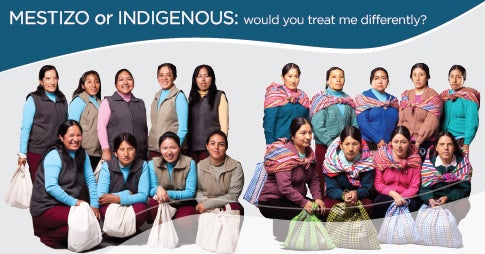Para leer en español, haz clic aquí
Ten women prepare themselves: hair, makeup, clothes, and posture. They practice proper cadence for scripted answers to questions they will soon be asked. Each of them will say she arrived in Lima from an Andean town seeking a brighter future for her two children. Her partner is returning after being away for six months for work, and they do not want to have any more children at the moment. No, she does not have any health issues. Yes, her childbirths were normal. She does not trust natural family planning methods and lacks experience using modern contraceptives. Today, they will be indigenous. Tomorrow, they will be mestizos.
For two weeks, these women trained to act as simulated patients in public family planning services in Lima and Callao, Peru. They are exploring whether quality of care varies if they present certain ethnic attributes of either mestizos or indigenous.
Years of contradictory policies discouraged Peruvian women from using contraception methods or pressured doctors to conduct involuntary sterilizations, particularly to poor and indigenous women. In 2004, the Ministry of Health began developing regulatory frameworks and clinical guidelines that would define quality standards in family planning, specifically relating to sexual and reproductive rights and the promotion of gender equality and diversity.
In Peru, ethnic disparities in contraceptive use remain: Only 21.9% of indigenous women use contraceptives, compared to 34.7% of non-indigenous women. Meanwhile, 9.4% for the indigenous women have unmet contraceptive needs, compared to 6.5% of non-indigenous women.
What is behind these statistics? Are these discrepancies arising from cultural differences between the two groups? Are they due to factors related to the health system organization and the behavior of health care providers? Or both?
Simulated patients for an innovative study
A study conducted by the IDB and Universidad Peruana Cayetano Heredia, with support from the Ministry of Health, sought to answer these questions. For this purpose, an experiment was conducted that involved 10 women between 25 and 35 years old with higher education, most of whom are midwives, who would play the role of patients. They conducted unannounced visits to family planning services at 351 of the 408 public health facilities in Lima and Callao.
During the visits, the simulated patients followed standardized scripts, which described their personal information, the reason for consultation, and basic medical information or contraceptive experience. They all had exactly the same characteristics; the only difference was that sometimes they presented as indigenous and other times as mestizos.
The characterization was achieved by modifying clothing, hairstyle, makeup, accessories, posture, cadence, and patterns of movement and body language. Through various validation analyses, before and after the intervention, it was confirmed that health providers for family planning would clearly identify the patients as mestizo or indigenous based on the presenting characterization.
After exiting each consultation, the women completed surveys through georeferenced mobiles that objectively assessed the time and cost of the consultation, and if the health care provider who served them met quality standards established by Ministry of Health regulations.
The study results suggest that the new users of family planning services do not receive differential treatment for being indigenous or mestizo. Irrespective of ethnic profile, however, they all receive lower quality care. On average, only 37% of the technical tasks required were conducted, and compliance with key competencies, such as providing an appropriate range of contraceptive methods and explaining the method of choice, was even lower.
Patients paid an average of 4 soles (US$1.4) for services that should be free, and it took two hours from the moment they arrived at the facility until they left the family planning consultation. On average the consultations lasted 13 minutes; which means that 90% of the time was spent on waiting and paperwork.
The results of the study highlight the need to investigate other determinants of supply and demand (for example, availability of supplies, resources, and staff) that may affect compliance with quality family planning standards. The results also highlight the need for interventions that will improve the quality of these services in Metropolitan Lima.
The study also exemplifies how using innovative methodologies can produce rigorous evidence that could not be obtained otherwise. While an evaluation of this scope requires effort, time, and other resources, the benefits justify the investment, as this opens new ways to improve the public policies that reduce health inequalities.
This study was published by PLOS ONE
 This post is part of the Development Effectiveness Overview (DEO), included in the chapter about impact evaluations. The DEO is an annual report produced by the IDB to show the results and impact of its work.
This post is part of the Development Effectiveness Overview (DEO), included in the chapter about impact evaluations. The DEO is an annual report produced by the IDB to show the results and impact of its work.



Leave a Reply